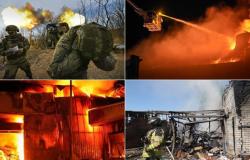North Korean leader Kim Jong-Un may actually be preparing for war, two prominent analysts have warned, despite widespread opinion that such a step would be a suicidal act on the part of the Pyongyang regime, Bloomberg reports.
North Korea built a nuclear submarine PHOTO Profimedia
Entering the 13th year of his reign, Kim is increasingly aggressively testing the limits of what his opponents are willing to tolerate, the American publication notes.
Confident of rapid progress in its nuclear capabilities and missile program, the 40-year-old North Korean dictator began the year by removing from the constitution the goal of peaceful unification with South Korea and instead proclaiming the right to “annihilate” it.
Normally, such belligerent rhetoric would be ignored – for example, as mere posturing ahead of South Korea’s April 10 election. Kim may not be bluffing this time, according to an analysis for the website 38 North published earlier this year.
“Just like his grandfather in 1950, Kim Jong-un made the strategic decision to go to war,” wrote former CIA officer Robert Carlin and nuclear scientist Siegfried Hecker, who, however, did not predict a deadline.
How the war could start between North and South Korea
Kim probably wouldn’t follow in his grandfather Kim Il Sung’s footsteps and invade South Korea. In 1950, China’s intervention after that invasion led to an armistice, but not to the signing of a peace treaty that is not in force to this day.
Instead, he has shown an appetite for smaller-scale challenges that could get out of hand, a trait he shares with his father, Kim Jong Il.
A hot spot are the islands bordering the Yellow Sea: although they are part of South Korea, they are in waters claimed by Pyongyang. In 2010, before Kim took power, Yeonpyeong Island was the scene of a deadly artillery bombardment that killed two South Korean soldiers and two civilians and burned homes. Six months later, South Korea accused North Korea of torpedoing its Cheonan warship, killing 46 sailors, a charge Pyongyang denied.
In the wake of these incidents, South Korea has vowed to respond strongly to any further attack, which would increase the chances of miscalculations on both sides that could quickly escalate.
“If North Korea creates a provocation, we will punish it several times as much,” conservative President Yoon Suk Yeol said in January after North Korea conducted artillery drills near a border island. The South Korean leader has taken a hard line against the Kim regime and has responded to its provocations with military exercises, often engaging the US in shows of force.
Attack on Seoul
Any potential escalating attack on the periphery would immediately target the Seoul region, home to about half of the country’s population of 51 million. For decades, North Korea has stored millions of artillery shells and thousands of missiles in the north of the demilitarized zone, located about 40 kilometers from South Korea’s largest city.
This border region is also home to about 70 percent of South Korea’s $1.67 trillion economy, the base for some of the world’s leading technology and manufacturing hubs, including Samsung Electronics Co., LG Electronics Inc . and Kia Corp. Even a short-term conflict would reverberate throughout global supply chains, disrupting the global economy.
In a typical display of an increasingly aggressive stance, Kim watched in March as his forces fired weapons that could be used in an attack on the South Korean capital. A minute-long artillery and missile barrage against Seoul could result in nearly 15,000 casualties, according to a 2020 Rand analysis. A one-hour one would increase that number to over 100,000.
Total conflict
A full-scale war launched by Kim Jong-un will likely begin with an artillery barrage on key military, political and economic targets in Seoul. North Korea keeps its howitzers, mortars and artillery rockets in fortified positions ready for just this purpose.
At the same time, about 200,000 soldiers from Kim’s special operations units – part of an active army of 1.1 million men – would try to cross the border by land, sea, air and even through tunnels, according to South Korean Ministry of Defense. One of the goals would be to target the bridges over the Han River, which runs through central Seoul, cutting the city in two and making it difficult for millions of people to flee to the less populated south of the peninsula.
But North Korea’s first-strike advantage is destined to be short-lived.
And South Korea is ready for battle: it has Patriot air defense systems, 555,000 active troops and a military budget larger than North Korea’s entire economy. In addition, there are 28,500 American troops in South Korea, along with spy satellites that constantly monitor the Korean Peninsula.
While North Korea has a manpower advantage, most of its forces rely on “increasingly outdated equipment” dating back to the Soviet Union, the Institute for International Studies has shown Strategic in its 2023 analysis of the world’s militaries. North Korea’s few Soviet fighter jets and its squadrons of single-propeller An-2s – developed in the 1950s and with a top speed of around 260 km/h would be easy prey for South Korea’s surface-to-air missiles South and the modern F-35A jets, which can fly over 1,200 miles per hour.
“The United States and South Korea would essentially instantly, from the very first moments of the war, have absolute air superiority in every way imaginable”, appreciated Michael Mazarr, senior political scientist at Rand. The same is true of other weapons systems: Pyongyang’s submarines are mostly small underwater junks that can’t stray too far from the coast because they’re easy to detect. Its tanks are from the Soviet era and are easily destroyed by the Javelin missile systems currently used in Ukraine to stop Russia.
What would escape the first waves of South Korean attacks would likely be bombarded in the following days, leaving North Korean cities vulnerable – just as happened in the first Korean War. “Inadequate availability of fuel and transportation, poor maintenance of land lines of communication, and insufficient training limit North Korea’s ability to sustain large-scale conventional offensive operations.”the US Defense Intelligence Agency wrote in a recent report.
“Bloody Nose” Kick
Another possibility is a “bloody nose” strike by the US and South Korea, an option discussed during the Trump administration. This scenario would only be on the table if allies have reason to believe a large-scale North Korean attack is imminent. This would be intended as a show of force to remind Kim that his military is no match for America’s might.
But the move has always been seen as risky, with the potential to spark widespread conflict. Moreover, in recent years, many of North Korea’s liquid-fuel missiles — which do not launch immediately — have been replaced by solid-fuel versions that Kim can quickly fire from train cars, lake beds and launchers hidden in caves with little or no warning.
If Kim makes an error of judgment, thinking the US and South Korea want to end his regime instead of sending a message of deterrence, he could preemptively use a nuclear weapon, said Duyeon Kim, a researcher in Seoul at the Center for a New American Security.
A US national intelligence estimate, which was declassified last year, said Kim would likely use his nuclear arsenal only if he believed his regime was in danger.
“Our analysis at this point is that he will engage in increasingly provocative behavior, but that no, he is not interested in escalating in the sense of all-out war, and there is some kind of limit to that,” US Director of National Intelligence Avril Haines told Congress in March.
If a larger North Korean attack seemed likely, South Korea would send bunker-busting missiles and fighter jets from its base south of Seoul. US bombers from Guam and ships and fighter jets from Japan could also come to South Korea’s aid.
The South Korea-US alliance would use air superiority to target command centers, weapons depots, missile launchers, radars, military bunkers, missile silos and nuclear storage facilities in an attempt to destroy as many of Korea’s weapons as possible north.
Targeting Kim Jong-un
Yoon did not shy away from discussing the so-called “Three Axis” plan consisting of pre-emptive strikes, large-scale attacks and the elimination of Kim. Thus, Pyongyang’s propaganda apparatus denounced South Korea for organizing “beheading units”, promising to destroy the “belligerent puppets” with a nuclear attack they will try.
Various estimates indicate that North Korea may have between 40 and 90 nuclear warheads. The Seoul-based Korea Institute for Defense Analysis has estimated that Kim wants between 100 and 300.
Attacking the Seoul region with one of North Korea’s most powerful bombs could cause about 400,000 deaths and 1.5 million casualties, Rand estimated. North Korea could also attack Japan, a US ally, or target US facilities in Guam or even North America, although opinion is divided over North Korea’s possession of ICBM technology.
In early April, the Kim regime tested a new missile it said could launch a nuclear-capable hypersonic glide vehicle capable of hitting US bases in Japan and Guam, saying it was “a state-of-the-art weapon” for protecting the nation.
North Korea has also sought to deploy lower-yield tactical nuclear weapons, possibly to deter a US-led counterattack.
“We assess that by 2030, Kim Jong Un will most likely continue a strategy of coercion, which may include lethal non-nuclear strikes, in order to advance the North’s goals of intimidating its neighbors, extracting concessions and to strengthen the regime’s military credibility domestically”says the latest US National Intelligence report.
Kim would have already invaded South Korea if he was actually preparing for war and not just for deterrence, according to Daniel Pinkston, a professor of international relations at Troy University in Seoul and a former US Air Force Korean linguist.
“North Korea’s leadership expects a restructuring of the world order and the collapse of the US-led alliance system in East Asia. If that doesn’t happen, I don’t see a theory of victory for North Korea.” he pointed out.






